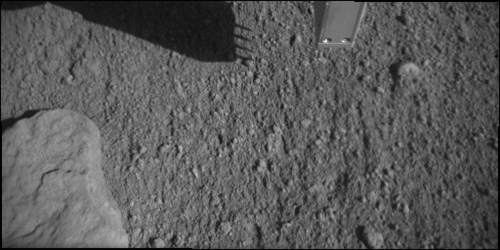It’s not that the Phoenix lander’s mission to Mars is over – not by a longshot. But Phoenix did stick a fork in it. The “fork” is a four-pronged thermal and electrical conductivity probe that Phoenix poked into the Martian soil for the first time. The probe tool can help the science team assess how easily heat and electricity move through the soil from one spike to another. These measurements can provide information about frozen or unfrozen water in the soil. The probe is mounted on the “knuckle” of Phoenix’s Robotic Arm. The probe has already been used for assessing water vapor in the atmosphere when it is held above the ground.
The image above is a series of six images, taken on July 8, 2008, during the Phoenix mission’s 43rd Martian day, or sol, since landing. The insertion visible from the shadows cast on the ground on that sol was a validation test of the procedure. The spikes on the probe are about 1.5 centimeters or half an inch long.
Phoenix also tried out another instrument: atomic force microscope. This Swiss-made microscope builds an image of the surface of a particle by sensing it with a sharp tip at the end of a spring, all micro- fabricated from a sliver of silicon. The sensor rides up and down following the contour of the surface, providing information about the target’s shape.
“The same day we first touched a target with the thermal and electrical conductivity probe, we first touched another target with a needle about threeorders of magnitude smaller — one of the tips of our atomic force microscope,”said Michael Hecht of NASA’s Jet Propulsion Laboratory, Pasadena, Calif., lead
scientist for the suite of instruments on Phoenix that includes both the conductivity probe and the microscopy station.
The atomic force microscope can provide details of soil-particle shapes as small as about 100 nanometers, less than one-hundredth the width of a human hair. This is about 20 times smaller than what can be resolved with Phoenix’s opticalmicroscope, which has provided much higher-magnification imaging than anythingseen on Mars previously.
The team for the robotic arm is still working out the best way to get samples of ice from the trench dug earlier called “Snow White,” and be able to transfer the samples quickly into the Thermal and Evolved-Gas Analyzer (TEGA) which heats samples and identifies vapors from them.
Scientists have yet to release any information about the second test from the Wet Chemistry Lab. They are still analyzing the results.
Original News Source: NASA’s Phoenix site


Scientists have yet to release any information about the second test from the Wet Chemistry Lab. They are still analyzing the results.
How long. It took 48 years to find out that there was water in the moon rocks!?
@Ralph
For some reason i thought we were astonished at how there was absolutely NO water in moon rocks.
“”Compared with terrestrial samples, all lunar rocks are oddballs because they are so dry,” Ryder said. “They contain no molecules of water, they’re not oxidized and they contain no ferric iron. They’re easy to distinguish from rocks on Earth.””
Of course this finding was established 30 years later so i’d rather wait a while longer than 48 hours to hear the real truth 😉
I also am a bit disappointed about the lack of information coming from phoenix.
What about the first wet chemistry results? They could at least have posted a summary.
To hd:
I agree. I took a look at the Phoenix lander website and virtually no technical info. So far, the perception from that this team seems to be generating is “limited information.” If they are still in analysis, why not say so and provide a status? Maybe we’re missing something and it’s there…
Like discussed in previous article’s comments, the Phoenix mission already has pretty conservative goals. Even at the end, what it’s telling us isn’t that much (especially when compared with the price of the mission). Look at the goals of the mission on the NASA website if you want further clarification on that~
However, I’m still 100% for the mission, though, because:
1) we did what we could with the resources available (I guess)
2) it was another successful Mars landing/mission, which is good support for future missions
3) we still are learning a lot about Mars..maybe the hype of the mission didn’t fit in with how much it’s telling us.
In any event, I do think the Phoenix is telling us what we wanted it to up to this point, so the mission has seemed pretty successful. In time we’ll know everything it can tell us, so just stay patient!
I find it very interesting that others share my concern about the analytical data. Unless I’m mistaken, the only “evidence for water” is the observed rate of sublimation of small chunks of ice uncovered by the scraper. Since the ice cap of Mars is composed mostly of frozen CO2, sublimation of a small chunk of ice is certainly not enough evidence to conclude water ice even exists on Mars. When do we get to see the analysis?
I thought an atomic force microscope needed a high vacuum? I know the atmo is thin on Mars but it ain’t vacuum. I guess I have not kept up. Okies, according to the Wiki, “While an electron microscope needs an expensive vacuum environment for proper operation, most AFM modes can work perfectly well in ambient air or even a liquid environment. This makes it possible to study biological macromolecules and even living organisms. In principle, AFM can provide higher resolution than SEM. It has been shown to give true atomic resolution in ultra-high vacuum (UHV). UHV AFM is comparable in resolution to Scanning Tunneling Microscopy and Transmission Electron Microscopy.”
So, it works in “air” but it cannot count individual atoms, I guess. Way cool.